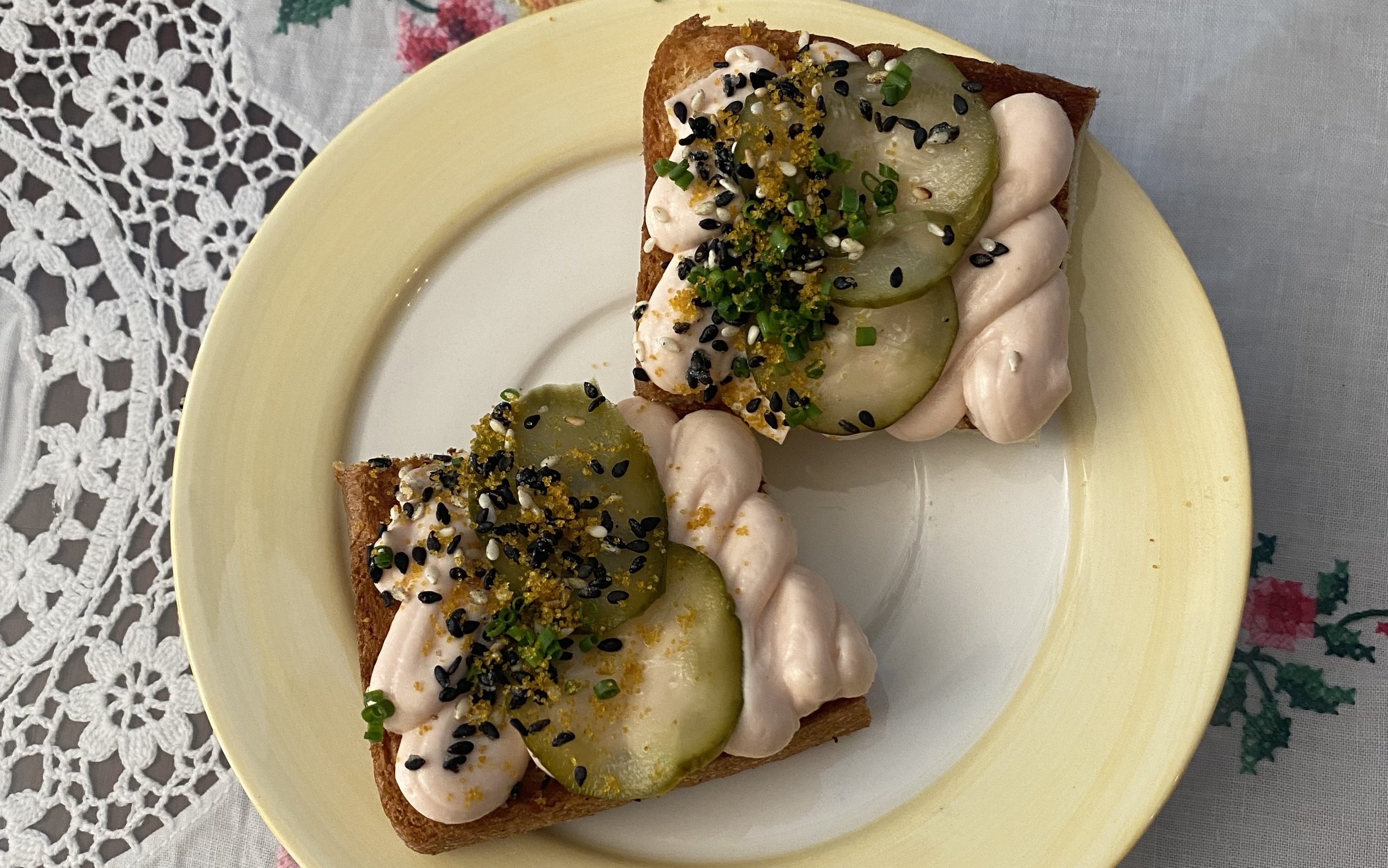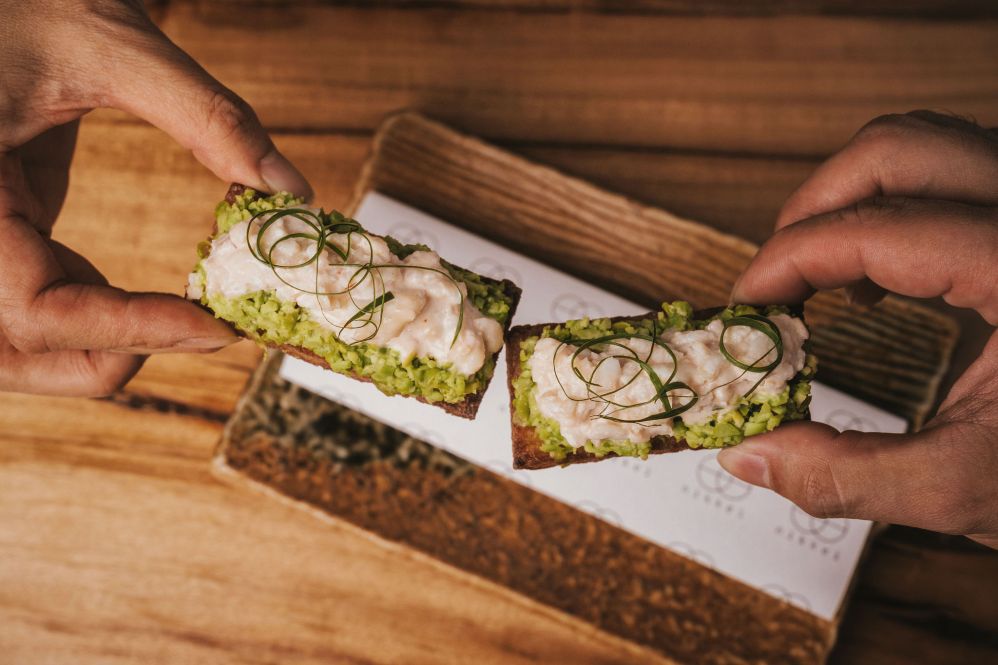There’s no doubt fusion cuisine has come a long way from nacho pizzas and sushi tacos. Like all trends, fusion peaked and fell in popularity, with arguably more down time as the dish combinations became more extravagant and harder to understand.
Fusion cuisine generates mixed reactions from both the industry and the dining public, but restaurants combining multiple culinary influences are beginning to reappear once again. Hospitality speaks with Baba’s Place, Nikkei Bar, and Oborozuki about redefining the ‘F word’ and ushering in a new chapter for the dining style; one that’s fresh, and most importantly, respectful of the origins it draws from.
Nestled in an industrial garage in Sydney’s Marrickville, Baba’s Place is a food-led celebration of the meals enjoyed in suburban communities. The inspiration is personal for Co-Owners Alexander Kelly, Jean-Paul El Tom, and James Bellos with the menu taking cues from their Lebanese, Macedonian, and Greek roots.
While the culinary offering came easy for the trio, defining Baba’s was another story. Intertwining different cultural backgrounds, dishes, and experiences led them to calling it suburban.
“The untold story is what goes on and what went on in those backyards — imagine an Italian household in the ’60s growing prickly pears, but then going down to Hurstville and shopping at an Asian market — that kind of mixing,” says Kelly.
The term suburban came from a state of confusion within the team and their experiences of immigrant communities. “To live in Sydney and to have family from other cultures is to be somewhat confused,” says Kelly. “We try to play with that and be a bit more generative and creative in the question of, ‘Who are we?’”
Kelly admits that while they’ve gone with the label of suburban for now, it is an ever-changing concept for the team. “I think we call it suburban more as a metaphor for the fact that suburbs change; gentrification, money, migration, all that stuff,” he says. “It’s playfully confusing, too because suburban, like what suburbs?” he laughs. “It frustrates everyone just as much as we want to figure it out.”
On the flip side, the sense of ambiguity that comes with the tag grants the
Baba’s Place team creative freedom with the menu as the kitchen isn’t limited or expected to follow certain rules of cuisines. As much as the suburban theme, the Baba’s Place menu is also led by experience.
Take the taramasalata toast: “It spoke to this domestic setting of having leftover dip your grandparents made and putting it on some bread — it’s a universal thing we all do. It doesn’t matter what background you’re from.”
The dish consists of taramasalata spread on shokupan with a garnish of praline,
bottarga, and house-made pickles. “We’re constantly trying to be like, ‘Here’s the
memory so let’s make it into what it looks like right now’.”
When it comes to fusion dining, Kelly believes that while the term is not one
that’s widely used now, it is one that has the potential to evolve. “It [fusion] has
dropped out of fashion and I think there has been a move in the last few years for people to replace it with terms like modern Australian or Australian,” he says. “Fusion might be a bad word and not a popular word right now, but maybe it’s coming back? I don’t know.”
Kelly does believe the label does raise questions around what makes a cuisine
and its people. “When we’re talking about cuisine, we’re inevitably talking about the people of that country and their histories,” he says. “You can’t just go, ‘Let’s mix it all together’. Because what you’re doing is erasing history and cultural differences.”
The erasure of culture in fusion cuisine is one of the reasons why Kelly believes it
has a negative reputation in the industry. “I do think people in the hospitality scene are trained to think there is some sort of appropriation and watering-down process going on when [it comes to] fusion,” he says. “I guess that’s why it’s been subbed out for modern Australian. Or maybe, to be cynical, what we call suburban. Maybe it’s just another way of calling something fusion?”
But the co-owner believes there is a respectful way to meld cuisines together
without diminishing cultures and their people. “I think there is a genuine attempt
to pay respect or feel the beauty of certain cultures through their food,” he says. “But I think it can go the wrong way when you fuse two stable cultures into one thing. [There is also] the idea of a stable cuisine or a culture you can pick from.”

Sydney’s Nikkei Bar opened in 2019 and serves Japanese–Peruvian food known as Nikkei cuisine. Nikkei has been around for more than 100 years and came about after large groups of Japanese immigrants arrived in Peru.
Joe Valero is the head chef at Nikkei Bar and says the venue has often been tagged as a fusion eatery. “Initially, our venue was seen as fusion,” he says.
“But once we tell people it’s come to be organically and it’s not just us saying,
‘Let’s mix Japanese and Peruvian food’, it makes them more excited. When it’s a
combination of two cuisines that don’t have much in common, it’s harder for
people to warm to it.”
When it comes to the label, Valero believes there is an association to a low-quality offering. “From what I’ve seen, it’s not a negative association, but it’s seen
more poorly than established cuisines,” explains the chef. “It does seem people see fusion as a bit of a cheap trick [because] there’s no tradition or history behind it, which can be a negative factor.”
The chef understands why diners may assume Nikkei Bar is a fusion venue,
but he believes the origins of the cuisine are important for guests to learn about
when they dine at the venue. “It’s understandable for people to be seeing this as fusion cuisine, which is what it is in itself,” he says. “But it’s also important for
people to see there is a history behind it.”
The Nikkei Bar menu incorporates techniques and ingredients from both
Japanese and Peruvian cuisines. “We don’t try to just recreate and go, ‘Let’s do
this traditional dish from Japan or this traditional dish from Peru’,” says the chef.
Valero lists the ceviche with ume leche de tigre and choclo corn as core examples
of the style of cooking. “The traditional marinade for ceviche would be done with just limes, seafood, chillies, and sometimes onion — that’s it,” says Valero. “But we use the Japanese ume plum and also use it throughout the dish.”
When Nikkei Bar opened, it was the only venue in Sydney serving the cuisine, but the sector has grown, which Valero believes is a testament to an interest in new, unique cuisines. The chef also believes Australia’s multiculturalism will see more cuisines like Nikkei emerge.
“Migration is not going to stop happening and it’s something we have to embrace,” he says. “We have to come up with exciting venues with new flavours.
There’s also something charming with having something less traditional.”

Sydney’s Oborozuki opened with a traditional Japanese teppanyaki and kaiseki dining experience in Circular Quay in 2022. But last month, the venue launched a Japanese–French menu from newly appointed Head Chef Daeun Kang. The move from a traditional offering to a more fluid approach was inspired by the venue’s
hope to stand out from the crowd and bring in new diners.
“As we sought to expand our offerings and appeal to a wider demographic,
we recognised the need for a more diverse and dynamic menu rather than following a more traditional route,” says Kang. “It was driven by a desire to strike a balance between catering to the local audience while retaining the essence of
Japanese cuisine.”
When it comes to being labelled as fusion, Kang says she prefers the focus to be on the balance of the two cuisines instead. “Our offering hinges on the integration of Japanese and French cuisines, and while the term fusion accurately describes our culinary approach, it’s also important to emphasise the balance and synergy we aim to achieve,” says the chef. “The flavours come together in a harmonious manner, rather than as a chaotic fusion.”
The culinary team hopes the blend of Japanese and French elements is well-received by guests. “Our goal is to offer a dining experience where the integration of Japanese and French elements is so seamless that it feels like a natural progression in the world of fine cuisine.”
Similarly to Valero, Kang believes Australia’s multiculturalism has led to the evolution of fusion dining across the country. “Australia boasts an abundance of diversity with influences from a multitude of countries,” says the chef. “This
melting pot of cultures has not only introduced a wide variety of flavours but also fostered an environment of culinary exploration.”
Kang does note it’s important for venues to have a purpose when it comes to the direction of the food offering. “As long as there is a clear and compelling purpose behind the fusion, it will continue to evolve and find its place in the culinary landscape,” she says.
Just like any dining trend, fusion has evolved from its origins to recreate itself in various forms with different labels. While some prefer not to namecheck fusion, others believe the story behind the label is vital to its growth to respectfully showcase multiple cuisines.
Sponsored Content

Celebrating coffee moments with Buondi
Sponsored by Nestlé Professional

Meet Force, the new player in commercial cookware
Sponsored by Tomkin
Trending Now
Resources
Lorem ipsum dolor sit amet, consectetur adipiscing elit. Fusce ac ornare lectus. Sed bibendum lobortis...
Lorem ipsum dolor sit amet, consectetur adipiscing elit. Fusce ac ornare lectus. Sed bibendum lobortis...
Sign up for our newsletter
